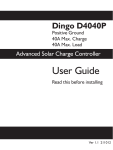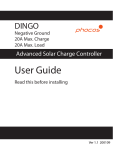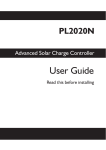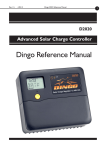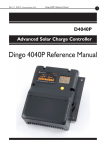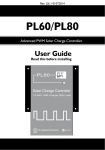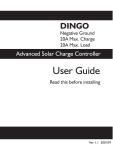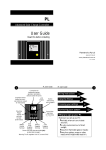Download PLA User Manual V1.5
Transcript
PLA User Manual V1.5 PLA Specification The PLA allows up to 3 PL series charge controllers to work together. The PLA provides a common communication interface, four alarm or control channel outputs, and can control a separate load control unit called an LS1. The PLA makes system performance data retrieval easier by providing a PC compatible way of collecting system total information. WARNING: read connection information(p5) before connecting PL controllers to the PLA Operating Conditions Battery Voltage Max Battery Voltage Min Relay Contact Voltage Max Relay Contact Current Max Supply Current Max Ambient Temperature 100V 8V 100V 0.3A 70mA (at 11V) Lower at higher voltages 22mA (at 48V) -20 to +60oC 1 System Management The PLA can be used on its own or as a manager for one, two or three PL controllers. The PL controllers can be PL20, PL40 or PL60 versions in any combination. However, for proper operation, the system voltages of all PL controllers and the PLA MUST be set to the same voltage. Charge Mode Synchronisation The PLA keeps the individual PL controllers synchronised. When one controller changes charge mode, then all the other controllers follow that change. This means that charging is properly shared between controllers. Without this synchronisation, a multi controller system can be trapped in the boost mode indefinitely if there is insufficient charge current from any one controller to reach the boost maximum voltage setting (BMAX). The PLA reads the controller charge mode once each minute. To cause a change in the PLA mode, the new mode must be read four times in a row. This is to stop false changes in mode due to electrical noise. This means that the PLA will take about 4 minutes to catch up with a change in mode of one of the PL controllers. When the PLA changes mode, it updates the mode in each PL controller. If there is an error in sending out the new system mode, the PL will resend the mode information to correct the error. For predictable operation, the corresponding charge mode settings in each PL controller should be the same. Maximum Boost Voltage (BMAX), Equalisation Time (EMAX), Equalisation Time (ETIM), Equalisation Frequency (EFRQ), Absorption Voltage (ABSV), Absorption Time (ATIM), Float Voltage (FLTV), Boost Return Voltage (BRTN), and Boost Frequency (BFRQ) Note: The controller will not go through the Equalisation mode unless one of the PL controllers moves into that mode. It will not stay in equalisation unless all the PL controllers have equalisation enabled. Hence, if an equalisation mode is required, all PL controllers must have the equalisation mode enabled. (i.e. a non zero ETIM) Time Synchronisation The time settings for the PL controllers are also kept in sync so that the measuring days correspond between units. The PLA uses the time on the PL plugged into socket 1 as the master. The time on the other PL controllers and the PLA is corrected to be the same as the master (PL1). This is done once a day when the time on the PLA gets to 11pm. (Note: this is for PLA versions 2.2+. Older versions used the PLA as the master). For this to work correctly, there must be a PL plugged into socket 1. To set the system time, set PL1 correctly and the rest will automatically syncronise to it at 11pm. 2 Alarms The PLA has high battery voltage and low battery voltage alarms available as voltage free optical relay contacts. The relay contacts are rated at 100V 0.3A. The alarm state indicators are normally green and change to red when the alarm is active. The low alarm activates when the battery voltage falls below the low alarm set point for more than 100 sec continuously. The low alarm deactivates again after more than 100sec above the alarm set point continuously. The high alarm activates when the battery voltage rises above the high alarm set point for more than 100 sec continuously. The high alarm deactivates again after more than 100sec below the alarm set point continuously. The alarm points are programmed via the serial port using PLCOM (version 2.07 or later) software and are stored in an EEPROM within the PLA. The settings are permanently stored, even if power is disconnected. The LS Output The LS relay output is normally on and turns off when the battery voltage drops below the load disconnect setting for 100sec. The LS relay output turns on when the battery voltage rises above the load reconnect voltage for 100sec. The LS output is the same as the control for the LS1 load switch. The LS output can be used as an alarm output to indicate that the load has been disconnected. It can also be used to switch off a load indirectly. The LS1 Load Switch The PLA can operate with a separate load control unit called an LS1. This allows system low battery voltage to cause load disconnection. The LS1 also measures the load current and provides fast short-circuit protection. The LS1 can carry up to 40A of load current. 3 The PLA directly controls the LS1. The PLA provides a signal to disconnect the load if the battery voltage is below the load disconnect voltage for 100sec continuously. The load switch will turn back on if the battery voltage rises again above the load reconnect voltage for 100sec. The 100sec time delays are to reduce the possibility of false disconnects due to load transients. In the event of the load current exceeding 70A, the LS1 will switch off the load current in about 2msec to prevent damage to the LS1 due to load short-circuits. The LS output provides a relay output that is normally closed and opens when the load disconnect is active and the load should be disconnected. This mirrors the state of the LS1 and can be used as a load disconnected alarm. The load disconnect and AUX settings can be adjusted in the same manner as the alarms. The PLA can operate without the LS1, but the LS1 requires the PLA to operate. The AUX Output The Auxiliary (AUX) relay output is normally on and turns off when the battery voltage drops below the AUXoff setting for 100sec. It reconnects when the battery voltage rises above the AUXon voltage for 100sec. The AUX Output can be used as a non-urgent alarm, an output for disconnecting nonessential loads or for generator control. Most generator controllers require a contact closure to indicate when the generator should run. When set up as an alarm, the AUX output will produce an open contact when the generator should run. This is the wrong way around for generator control. The Mode setting allows this operation to be reversed. If Mode is set to between 8 and 15, then the AUX output will be open when inactive and closed when active – as is required for generator start operation. 4 Connection WARNING! : If PL controllers are connected to the PLA, then correct connection of the PLA power is essential to avoid damage to the PL and possibly the PLA. Positive Ground (All PL controllers) Connect the battery positive(+) side (ground) to the terminal labeled + (Common). Connect battery negative(-) side (switched or active) to the terminal labeled -(Active). (If the PLA is to be used on its own, then it does not matter which way the power is connected to it. It will work with voltages of either polarity. When first connected, the PLA assumes a positive ground connection. If it is actually connected as negative ground, it will automatically swap to negative ground after 20 seconds.) The alarm and control connections are directly underneath their respective leds. The three connectors for PL controllers are on the top side, as is the 10 pin connector for the LS1. Note: there must be a PL connected to socket 1 for correct time syncronisation. Baud Rate Jumper There is a jumper to the right of the serial port connection. When this is connected, it forces the PLA baud rate to 2400 baud. This is useful if the user does not know what baud rate has been set on the PLA. The PLA will be shipped with the jumper on (= set to 2400 baud.) 5 System Monitoring The PLA makes multi PL controller system monitoring easier. All the system data is collected together and the total system performance can be read by one download instead of downloading each controller and adding them together. A Personal Computer can interface directly with a PLA via a DC isolated RS232 serial port. To communicate with a PLA, PLCOM software (version 2.07 or later) is needed. The user needs to select the 'site' mode of operation. This allows the user to communicate with each of the PL controllers or the PLA. The PL connections 1, 2 and 3 on the PLA are allocated site numbers 1,2 and 3 respectively. The PLA is allocated site number 4. The device to communicate with is selected by setting the site number using the PLCOM site select button. The following data is available from the PLA. (When Site = 4) Battery Voltage Battery voltage as read by the PLA Charge Current Sum of the charge currents in PL 1 to 3 (1A resolution. Maximum 255A) Load Current Sum of the load currents in PL 1 to 3 and the LS1 (1A resolution. Maximum 255A) Charge Amp Hours Sum of Charge Ah from PL 1 to 3 for that day (Max 4000Ah) Load Amp Hours Sum of Load Ah from PL 1 to 3 plus LS1 load Ah for that day (Max 4000Ah) Bat Volts Max Battery Voltage Maximum for the day Bat Volts Min Battery Voltage Minimum for the day (note: Bat Max and Min scaled to the PLA system voltage and will change if the PLA system voltage setting is changed) History Data Sums or averages each individual history entry and adds in the Load amp hours from the LS1. Ah figures are added – all others are averaged. The LS1 daily load amphours for the last 30days are stored in the PLA EEPROM. 6 PLA Programming The PLA is programmed via its RS232 serial port using PLCOM 2.07 or later. PLCOM is proprietary software of Plasmatronics Pty Ltd. Setting Ranges System Voltage 12V system 24V system 48V system Adjustment range for all sets points 10V to 17V 20V to 34V 40V to 68V Baud Rates : 300,1200, 2400, 9600 Baud How to Program a PLA 1. Connect the PLA to a source of power. A 12V battery or plug pack will do. 2. Connect the PLA serial port to the computer serial port using a standard IBM compatible 9pin serial cable. The PLA serial port is DC isolated so the possibility of grounding problems is reduced. 3. Open the PLCOM software and press the Modem setup button. 4. Select the appropriate baud rate and port for the 'Direct' connection. The port number must be the same as the port you have the cable plugged into and the Baud rate must match what the PLA is set to. (If you do not know what baud rate the PLA is set to, then it can be forced to 2400 baud. This is done by placing a jumper on the two pins labeled ‘2400’, to the right of the serial port connector.) Set the time delay setting (at the bottom of the window) to maximum (=20). 7 5. Press the Tools button to bring up the tools selection box. If the furthest right button on the top bar shows the word LOG then select the 'Set Site mode command from the tools drop down list. This will change the program into site mode. The button will change to show the 'Site Number'. 6. Press the Site select button and set the site number to 4. (The PLA site number) After setting this up, you can confirm communication with the PLA by doing a Loopback test. Select Loopback from the Tools drop down menu. Click the Send button and the number 4 should appear in the reply window. 8 7. From the tools selection list select 'Program PLA'. The PLA programming utility window will open. 8. Press the Read PLA setting button and wait until the settings are read out. An initial read is needed to actually load the settings in the PLA. The ones initially displayed are a factory default set. 9. Adjust the settings to those desired. The entries will change to acceptable values when the mouse is moved from the cell or enter is pressed. 10. Press the Write to PLA button to program the settings into the PLA. 11. Read the settings back again to check the programming was correct. The checksum window should show OK (Green). If the Checksum shows Bad (Red) then write the settings to the PLA again and read back again. This should fix the problem. If not, there is a communication problem. Check your setup and consult your dealer. Note: Setting changes do not become active in the PLA immediately. They will become active automatically within 6 minutes. Alternatively, disconnect the PLA power and then reconnect. Settings are updated on powerup. The settings are stored in a non-volatile EEPROM and so are not lost when the power is disconnected. 9 Mode Settings The operation of the PLA can be altered by use of the Mode setting in the PLA Programmer inside PLCOM. The factory setting for Mode is 0. Changing the Relay Operation The alarm and output relay contacts are closed when the alarm condition is not active and open when it is active. This is the usual form of operation for 'fail safe' alarms because if the alarm connection is broken then the alarm will operate. The sense of operation of any of the outputs can be reversed using the mode setting. For example, the AUX output can be used as a generator controller, which often requires a contact closure to run, eg modes 8-15. For a quicker alarm response time, modes 16 to 31 can be used to make the alarms occur in 5 seconds instead of the standard 100 seconds. On power up, modes 16 to 31 need a minute to stabilise before they give reliable results. The following table displays the effect of different Mode options. (NC = normally closed, NO = normally open) Mode for Mode for Low High LS AUX 100s Alarm 5s Alarm Alarm Alarm Output Output 0 1 2 3 4 5 6 7 8 9 10 11 12 13 14 15 16 17 18 19 20 21 22 23 24 25 26 27 28 29 30 31 NC NO NC NO NC NO NC NO NC NO NC NO NC NO NC NO NC NC NO NO NC NC NO NO NC NC NO NO NC NC NO NO NC NC NC NC NO NO NO NO NC NC NC NC NO NO NO NO NC NC NC NC NC NC NC NC NO NO NO NO NO NO NO NO 10










